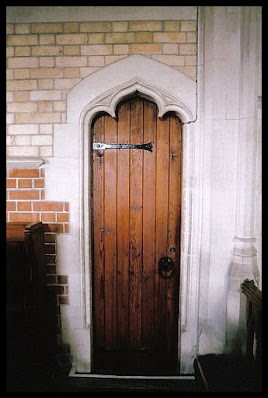Just before I went to visit this chapel in 2011, I'd recently had two surprises of some amazing architecture and other delights while visiting the parish churches of Sidmouth and Lyme Regis. I honestly didn't expect to find any more but, as things tend to turn up in threes, I really should have known better!
It's an easy visit within walking distance but I'd left it for a time when there wasn't anything else to do. So, having saved this one for a rainy day, I decided to go on a very hot April afternoon instead. ;)
Although only a little over a hundred years old, it really is a lovely building. Completed in 1889, this was the first time in some three centuries that there was once again a place of worship in Colyford; the former chantry of St Edmunds having disappeared from use. Erected in remembrance of Admiral John Impey by his daughter and grandson, the chapel is built in the decorated style, consisting of brick with a flint facing and dressings of Beer Stone from the limestone quarry situated above the nearby Beer village.
Entering by the south-west door I came across my first surprise; an interior porch formed by screens consisting of plain and coloured glass panels - enabling warm light into an area which can often be quite dark in traditional churches.
The roof consists of pitched pine with curved boarded ceilings; the interior quite spacious with room for around two hundred people.
Looking down towards the entrance from the chancel, below. On the left is the south transept where the font is also situated. The glass-panelled porch can be seen left of centre.
The font is constructed from the local Beer Stone with a Ham Hill and Corsehill base. Ham Hill stone is also fairly local, from Somerset, whereas Corsehill stone comes from a quarry in Dumfries and Galloway and is a fine grained pink/red sandstone.
The north side below, looking towards the chancel.
A squint in the south transept wall enables those sitting in there during services to see through to the sanctuary, below.
And now, the other surprise that I had when entering the nave and looking towards the east end was this stunning carved oak reredos - most unexpected in a humble chapel of ease. It was modelled upon 'The Entombment' by the Renaissance artist, Bartolemmeo.
The exterior has a pleasing aspect with some interesting features. The photos below show the west gable with a bell turret constructed in Beer Stone, containing a single bell and topped with a metal cross.
A cute little gabled trefoil window nestles between two adjacent walls on the south-east corner.
Adjoining the chapel is a stone house which was built as a rectory. The intention was to establish a separate parish in Colyford, but the chapel came under the care of the rector at Colyton in 1903 and the house was sold as a private residence.
I wasn't very pleased with the exterior photos - a bit pale and wishy-washy, with the pinky/lime green cast often captured on film in Spring - which is why I haven't included many. I've put a few below though, for completion. :)
Altogether a lovely visit and much more satisfying than I had expected.


















































